Determinants of Honey and Other Bee Products Use for Culinary, Cosmetic, and Medical Purposes
Abstract
1. Introduction
- -
- Determination of the frequency of use of honey for culinary, medicinal, and cosmetic purposes;
- -
- Determination of the ways in which honey is used for culinary and cosmetic purposes and the health reasons conditioning its therapeutic use;
- -
- Determination of the prevalence of the use of bee products other than honey for culinary, medicinal, and cosmetic purposes;
- -
- Segmentation of consumers who use honey and other bee products with different frequencies;
- -
- Assessment of the relationship between the level of nutritional knowledge of consumers and their use of honey and other bee products;
- -
- Assessment of the relationship between consumers’ health status and their use of honey and other bee products.
2. Materials and Methods
2.1. Study Design and Participants
2.2. Questionnaire
2.3. Statistical Analysis
2.4. Characteristics of Respondents
3. Results
3.1. Bee Products Usage for Consumption, Cosmetic and Medical Purposes
3.2. Ways of Honey Usage for Culinary, Cosmetic, and Medical Purposes
3.3. Consumer Segmentation
3.3.1. Demographic and Economic Profile of the Segments
3.3.2. Use of Other Than Honeybee Products by Distinguished Segments
3.3.3. Reasons for the Use of Bee Products by Distinguished Segments
3.3.4. Sources of Information on Bee Products Used by the Identified Segments
3.3.5. Self-Assessment of Nutritional Knowledge and Health Status in Distinguished Segments
3.4. Influence of Nutritional Knowledge and Health Status on the Use of Bee Products
4. Discussion
5. Conclusions
Supplementary Materials
Author Contributions
Funding
Institutional Review Board Statement
Informed Consent Statement
Data Availability Statement
Conflicts of Interest
References
- Ahangari, Z.; Naseri, M.; Vatandoost, F. Propolis: Chemical Composition and Its Applications in Endodontics. Iran. Endod. J. 2018, 13, 285. [Google Scholar] [PubMed]
- Crittenden, A.N. The Importance of Honey Consumption in Human Evolution. Food Foodways 2011, 19, 257–273. [Google Scholar] [CrossRef]
- Bogdanov, S. Honey as Nutrient and Functional Food. Bee Prod. Sci. 2016, 19. [Google Scholar]
- Münstedt, K.; Bogdanov, S. Bee Products and Their Potential Use in Modern Medicine. J. ApiProduct ApiMedical Sci. 2009, 1, 57–63. [Google Scholar] [CrossRef]
- Martinello, M.; Mutinelli, F. Antioxidant Activity in Bee Products: A Review. Antioxidants 2021, 10, 71. [Google Scholar] [CrossRef]
- Premratanachai, P.; Chanchao, C. Review of the Anticancer Activities of Bee Products. Asian Pac. J. Trop. Biomed. 2014, 4, 337–344. [Google Scholar] [CrossRef]
- Papa, G.; Maier, R.; Durazzo, A.; Lucarini, M.; Karabagias, I.K.; Plutino, M.; Bianchetto, E.; Aromolo, R.; Pignatti, G.; Ambrogio, A. The Honey Bee Apis Mellifera: An Insect at the Interface between Human and Ecosystem Health. Biology 2022, 11, 233. [Google Scholar] [CrossRef]
- Bogdanov, S.; Jurendic, T.; Sieber, R.; Gallmann, P. Honey for Nutrition and Health: A Review. J. Am. Coll. Nutr. 2008, 27, 677–689. [Google Scholar] [CrossRef] [PubMed]
- Murray, S.S.; Schoeninger, M.J.; Bunn, H.T.; Pickering, T.R.; Marlett, J.A. Nutritional Composition of Some Wild Plant Foods and Honey Used by Hadza Foragers of Tanzania. J. Food Compos. Anal. 2001, 14, 3–13. [Google Scholar] [CrossRef]
- Qamer, S.; Ehsan, M.; Nadeem, S.; Shakoori, A.R. Free Amino Acids Content of Pakistani Unifloral Honey Produced by Apis Mellifera. Pak. J. Zool. 2007, 39, 99. [Google Scholar]
- Marghitas, L.A.; Dezmirean, D.S.; Pocol, C.B.; Marioara, I.; Bobis, O.; Gergen, I. The Development of a Biochemical Profile of Acacia Honey by Identifying Biochemical Determinants of Its Quality. Not. Bot. Horti Agrobot. Cluj-Napoca 2010, 38, 84–90. [Google Scholar]
- Muhammad, A.; Odunola, O.A.; Gbadegesin, M.A.; Adegoke, A.M.; Olugbami, J.O.; Uche, N.S. Modulatory Role of Acacia Honey from North-West Nigeria on Sodium Arsenite-Induced Clastogenicity and Oxidative Stress in Male Wistar Rats. Nat. Prod. Res. 2015, 29, 321–326. [Google Scholar] [CrossRef]
- Testa, R.; Asciuto, A.; Schifani, G.; Schimmenti, E.; Migliore, G. Quality Determinants and Effect of Therapeutic Properties in Honey Consumption. An Exploratory Study on Italian Consumers. Agriculture 2019, 9, 174. [Google Scholar] [CrossRef]
- Bilsel, Y.; Bugra, D.; Yamaner, S.; Bulut, T.; Cevikbas, U.; Turkoglu, U. Could Honey Have a Place in Colitis Therapy? Effects of Honey, Prednisolone, and Disulfiram on Inflammation, Nitric Oxide, and Free Radical Formation. Dig. Surg. 2002, 19, 306–312. [Google Scholar] [CrossRef] [PubMed]
- Jull, A.B.; Cullum, N.; Dumville, J.C.; Westby, M.J.; Deshpande, S.; Walker, N. Honey as a Topical Treatment for Wounds. Cochrane Database Syst. Rev. 2015, 2015, CD005083. [Google Scholar] [CrossRef] [PubMed]
- Lusby, P.E.; Coombes, A.L.; Wilkinson, J.M. Bactericidal Activity of Different Honeys against Pathogenic Bacteria. Arch. Med. Res. 2005, 36, 464–467. [Google Scholar] [CrossRef]
- Al-Waili, N. Intrapulmonary Administration of Natural Honey Solution, Hyperosmolar Dextrose or Hypoosmolar Distill Water to Normal Individuals and Patients with Type-2 Diabetes Mellitus or Hypertension: Their Effects on Blood Glucose Level, Plasma Insulin and C-Pep. Eur. J. Med. Res. 2003, 8, 295–303. [Google Scholar]
- Fakhrildin, M.-B.M.R.; Alsaadi, R.A.R. Honey Supplementation to Semen-Freezing Medium Improveshuman Sperm Parameters Post-Thawing. J. Fam. Reprod. Health 2014, 8, 27. [Google Scholar]
- Kopczyńska, D.; Klasik-Ciszewska, S.; Duda-Grychtoł, K. Produkty Pszczele w Pielęgnacji Skóry. Med. Rodz. 2018, 21, 48–52. [Google Scholar] [CrossRef]
- Burlando, B.; Cornara, L. Honey in Dermatology and Skin Care: A Review. J. Cosmet. Dermatol. 2013, 12, 306–313. [Google Scholar] [CrossRef]
- Kurek-Górecka, A.; Górecki, M.; Rzepecka-Stojko, A.; Balwierz, R.; Stojko, J. Bee Products in Dermatology and Skin Care. Molecules 2020, 25, 556. [Google Scholar] [CrossRef]
- Abdelnour, S.A.; Abd El-Hack, M.E.; Alagawany, M.; Farag, M.R.; Elnesr, S.S. Beneficial Impacts of Bee Pollen in Animal Production, Reproduction and Health. J. Anim. Physiol. Anim. Nutr. 2019, 103, 477–484. [Google Scholar] [CrossRef] [PubMed]
- Mărgăoan, R.; Stranț, M.; Varadi, A.; Topal, E.; Yücel, B.; Cornea-Cipcigan, M.; Campos, M.G.; Vodnar, D.C. Bee Collected Pollen and Bee Bread: Bioactive Constituents and Health Benefits. Antioxidants 2019, 8, 568. [Google Scholar] [CrossRef] [PubMed]
- Nascimento, A.; Luz, G.E., Jr. Bee Pollen Properties: Uses and Potential Pharmacological Applications-a Review. J. Anal. Pharm. Res. 2018, 7, 513–515. [Google Scholar] [CrossRef]
- Xi, X.; Li, J.; Guo, S.; Li, Y.; Xu, F.; Zheng, M.; Cao, H.; Cui, X.; Guo, H.; Han, C. The Potential of Using Bee Pollen in Cosmetics: A Review. J. Oleo Sci. 2018, 67, ess18048. [Google Scholar] [CrossRef] [PubMed]
- Bachevski, D.; Damevska, K.; Simeonovski, V.; Dimova, M. Back to the Basics: Propolis and COVID-19. Dermatol. Ther. 2020, 33, e13780. [Google Scholar] [CrossRef] [PubMed]
- Pasupaleti, V.R. Honey, Propolis, and Royal Jelly: A Comprehensive Review of Their Biological Actionsand Health Benefits. Oxidative Med. Cell. Longev. 2017, 2017, 1259510. [Google Scholar] [CrossRef]
- Bankova, V.S.; de Castro, S.L.; Marcucci, M.C. Propolis: Recent Advances in Chemistry and Plant Origin. Apidologie 2000, 31, 3–15. [Google Scholar] [CrossRef]
- Braakhuis, A. Evidence on the Health Benefits of Supplemental Propolis. Nutrients 2019, 11, 2705. [Google Scholar] [CrossRef]
- Kowacz, M.; Pollack, G.H. Propolis-Induced Exclusion of Colloids: Possible New Mechanism of Biological Action. Colloid Interface Sci. Commun. 2020, 38, 100307. [Google Scholar] [CrossRef]
- Alkis, H.E.; Kuzhan, A.; Dirier, A.; Tarakcioglu, M.; Demir, E.; Saricicek, E.; Demir, T.; Ahlatci, A.; Demirci, A.; Cinar, K. Neuroprotective Effects of Propolis and Caffeic Acid Phenethyl Ester (CAPE) on the Radiation-Injured Brain Tissue (Neuroprotective Effects of Propolis and CAPE). Int. J. Radiat. Res. 2015, 13, 297–303. [Google Scholar]
- Rivera-Yañez, N.; Rivera-Yañez, C.R.; Pozo-Molina, G.; Méndez-Catalá, C.F.; Méndez-Cruz, A.R.; Nieto-Yañez, O. Biomedical Properties of Propolis on Diverse Chronic Diseases and Its Potential Applications and Health Benefits. Nutrients 2020, 13, 78. [Google Scholar] [CrossRef] [PubMed]
- Olczyk, P.; Komosinska-Vassev, K.; Wisowski, G.; Mencner, L.; Stojko, J.; Kozma, E.M. Propolis Modulates Fibronectin Expression in the Matrix of Thermal Injury. BioMed Res. Int. 2014, 2014, 748101. [Google Scholar] [CrossRef] [PubMed]
- Fontana, R.; Mendes, M.A.; De Souza, B.M.; Konno, K.; César, L.M.M.; Malaspina, O.; Palma, M.S. Jelleines: A Family of Antimicrobial Peptides from the Royal Jelly of Honeybees (Apis Mellifera). Peptides 2004, 25, 919–928. [Google Scholar] [CrossRef]
- McCleskey, C.S.; Melampy, R.M. Bactericidal Properties of Royal Jelly of the Honeybee. J. Econ. Entomol. 1939, 32, 581–587. [Google Scholar] [CrossRef]
- Almeer, R.S.; AlBasher, G.I.; Alarifi, S.; Alkahtani, S.; Ali, D.; Abdel Moneim, A.E. Royal Jelly Attenuates Cadmium-Induced Nephrotoxicity in Male Mice. Sci. Rep. 2019, 9, 1–12. [Google Scholar] [CrossRef]
- You, M.-M.; Chen, Y.-F.; Pan, Y.-M.; Liu, Y.-C.; Tu, J.; Wang, K.; Hu, F.-L. Royal Jelly Attenuates LPS-Induced Inflammation in BV-2 Microglial Cells through Modulating NF-ΚB and P38/JNK Signaling Pathways. Mediat. Inflamm. 2018, 2018, 7834381. [Google Scholar] [CrossRef]
- Miyata, Y.; Sakai, H. Anti-Cancer and Protective Effects of Royal Jelly for Therapy-Induced Toxicities in Malignancies. Int. J. Mol. Sci. 2018, 19, 3270. [Google Scholar] [CrossRef]
- Hattori, N.; Nomoto, H.; Fukumitsu, H.; Mishima, S.; Furukawa, S. Royal Jelly and Its Unique Fatty Acid, 10-Hydroxy-Trans-2-Decenoic Acid, Promote Neurogenesis by Neural Stem/Progenitor Cells in Vitro. Biomed. Res. 2007, 28, 261–266. [Google Scholar] [CrossRef]
- Chiu, H.-F.; Chen, B.-K.; Lu, Y.-Y.; Han, Y.-C.; Shen, Y.-C.; Venkatakrishnan, K.; Golovinskaia, O.; Wang, C.-K. Hypocholesterolemic Efficacy of Royal Jelly in Healthy Mild Hypercholesterolemic Adults. Pharm. Biol. 2017, 55, 497–502. [Google Scholar] [CrossRef]
- Yoon, B.-K.; Chin, J.; Kim, J.-W.; Shin, M.-H.; Ahn, S.; Lee, D.-Y.; Seo, S.W.; Na, D.L. Menopausal Hormone Therapy and Mild Cognitive Impairment: A Randomized, Placebo-Controlled Trial. Menopause 2018, 25, 870–876. [Google Scholar] [CrossRef] [PubMed]
- Collazo, N.; Carpena, M.; Nuñez-Estevez, B.; Otero, P.; Simal-Gandara, J.; Prieto, M.A. Health Promoting Properties of Bee Royal Jelly: Food of the Queens. Nutrients 2021, 13, 543. [Google Scholar] [CrossRef] [PubMed]
- Maleki, V.; Jafari-Vayghan, H.; Saleh-Ghadimi, S.; Adibian, M.; Kheirouri, S.; Alizadeh, M. Effects of Royal Jelly on Metabolic Variables in Diabetes Mellitus: A Systematic Review. Complement. Ther. Med. 2019, 43, 20–27. [Google Scholar] [CrossRef] [PubMed]
- Dębek, K.; Kalinowski, M.; Mastalerczyk, A.; Dąbrowski, J.; Boguszewska-Czubara, A. Zastosowanie Kukurbitacyny B w Terapii Nowotworów. In Wybrane Zagadnienia z Zakresu Produkcji Surowców, Żywności i Kosmetyków; Wydawnictwo Uniwersytetu Przyrodniczego w Lublinie: Lublin, Poland, 2021; pp. 30–36. [Google Scholar]
- Svečnjak, L.; Chesson, L.A.; Gallina, A.; Maia, M.; Martinello, M.; Mutinelli, F.; Muz, M.N.; Nunes, F.M.; Saucy, F.; Tipple, B.J.; et al. Standard Methods for Apis Mellifera Beeswax Research. J. Apic. Res. 2019, 58, 1–108. [Google Scholar] [CrossRef]
- Kasparaviciene, G.; Savickas, A.; Kalveniene, Z.; Velziene, S.; Kubiliene, L.; Bernatoniene, J. Evaluation of Beeswax Influence on Physical Properties of Lipstick Using Instrumental and Sensory Methods. Evid.-Based Complement. Altern. Med. 2016, 2016, 3816460. [Google Scholar] [CrossRef] [PubMed]
- Samarghandian, S.; Farkhondeh, T.; Samini, F. Honey and Health: A Review of Recent Clinical Research. Pharmacogn. Res. 2017, 9, 121. [Google Scholar]
- Ványi, G.Á.; Csapó, Z.; Kárpáti, L. Evaluation of Consumers’ Honey Purchase Habits in Hungary. J. Food Prod. Mark. 2011, 17, 227–240. [Google Scholar] [CrossRef]
- Zamudio, F.; Kujawska, M.; Hilgert, N.I. Honey as Medicinal and Food Resource. Comparison between Polish and Multiethnic Settlements of the Atlantic Forest, Misiones, Argentina. Open Complement. Med. J. 2010, 2, 58–73. [Google Scholar] [CrossRef]
- Batt, P.J.; Liu, A. Consumer Behaviour towards Honey Products in Western Australia. Br. Food J. 2012, 114, 285–297. [Google Scholar] [CrossRef]
- Bianca, P.C. Modelling the Honey Consumption Behaviour in Romania by Using Socio-Demographic Determinants. Afr. J. Agric. Res. 2011, 6, 4069–4080. [Google Scholar]
- Oliveira Neto, W.M.D.; Paiva, R.D.N.; Novais, J.S.D. Consumo de Miel: Análisis Bibliométrico y Revisión Sistemática. Agroaliment. J.-Rev. Agroaliment. 2021, 27, 141–154. [Google Scholar] [CrossRef]
- Koch, F.; Hoffmann, I.; Claupein, E. Types of Nutrition Knowledge, Their Socio-Demographic Determinants and Their Association with Food Consumption: Results of the Nemonit Study. Front. Nutr. 2021, 8, 630014. [Google Scholar] [CrossRef]
- Scalvedi, M.L.; Gennaro, L.; Saba, A.; Rossi, L. Relationship between Nutrition Knowledge and Dietary Intake: An Assessment among a Sample of Italian Adults. Front. Nutr. 2021, 8, 714493. [Google Scholar] [CrossRef]
- Gül, E.; Erci, B. Investigating the Correlation of Health Literacy with Eating Behavior and Health Perception in Adult Individuals. Int. J. Health Promot. Educ. 2022, 1–15. [Google Scholar] [CrossRef]
- Zavodna, L.S.; Pospisil, J.Z. Honey Bee: A Consumer’s Point of View. Environ. Socio-Econ. Stud. 2016, 4, 26–32. [Google Scholar] [CrossRef]
- Yeow, S.H.C.; Chin, S.T.S.; Yeow, J.A.; Tan, K.S. Consumer Purchase Intentions and Honey Related Products. J. Mark. Res. Case Stud. 2013, 2013, 197440. [Google Scholar] [CrossRef]
- Aytop, Y.; Akbay, C.; Meral, H. Consumers Behavior Towards Bee Products Consumption in The Centre District of Kahramanmaras Province. Kahramanmaraş Sütçü İmam Üniv. Tarım Ve Doğa Derg. 2019, 22, 449–455. [Google Scholar]
- Jylhä, M. What Is Self-Rated Health and Why Does It Predict Mortality? Towards a Unified Conceptual Model. Soc. Sci. Med. 2009, 69, 307–316. [Google Scholar] [CrossRef]
- Kopała, E.; Kuźnicka, E.; Balcerak, M. Survey of Consumer Preferences on the Bee Product Market. Part 1. Honey. Ann. Warsaw Univ. Life Sci. Anim. Sci. 2019, 58, 153–158. [Google Scholar] [CrossRef]
- Roman, A.; Popiela-Pleban, E.; Kozak, M.; Roman, K. Factors Influencing Consumer Behavior Relating to the Purchase of Honey Part 2. Product Quality and Packaging. J. Apic. Sci. 2013, 57, 175–185. [Google Scholar] [CrossRef]
- Schifani, G.; Romeo, P.; Dara Guccione, G.; Schimmenti, E.; Columba, P.; Migliore, G. Conventions of Quality in Consumer Preference toward Local Honey in Southern Italy. Qual. Success 2016, 17, 92–97. [Google Scholar]
- Kafantaris, I.; Amoutzias, G.D.; Mossialos, D. Foodomics in Bee Product Research: A Systematic Literature Review. Eur. Food Res. Technol. 2021, 247, 309–331. [Google Scholar] [CrossRef]
- Ismaiel, S.; Al Kahtani, S.; Adgaba, N.; Al-Ghamdi, A.A.; Zulail, A. Factors That Affect Consumption Patterns and Market Demands for Honey in the Kingdom of Saudi Arabia. Food Nutr. Sci. 2014, 2014, 1725–1737. [Google Scholar] [CrossRef]
- Guziy, S.; Šedík, P.; Horská, E. Comparative Study of Honey Consumption in Slovakia and Russia. Potravin. Slovak J. Food Sci. 2017, 11, 472–479. [Google Scholar] [CrossRef] [PubMed]
- Pocol, C.B.; Šedík, P.; Horská, E. Honey Consumption Patterns of Young People in Romania. Int. Sci. Days 2018, 435–446. [Google Scholar]
- Hudecova, M. Analysis of Consumer Behaviour on the Bee Products Market in Relation to the Health Trends. In Challenges of Nowadays in the Light of Sustainability; Hungarian University of Agriculture and Life Sciences: Gödöllő, Hungary, 2021; p. 60. [Google Scholar]
- Pocol, C.B. Consumer Preferences for Different Honey Varieties in the North West Region of Romania. Lucr. Stiint. Ser. Agron. 2012, 55, 263–266. [Google Scholar]
- Pocol, C.B.; Árvánéványi, G. A Comparison between Hungarian and Romanian Honey Consumption. Bull. Univ. Agric. Sci. Vet. Med. Cluj-Napoca. Hortic. 2012, 69, 244–252. [Google Scholar]
- Šniepienė, G.; Jankauskienė, R. Organic Personal Care Cosmetics: Behavior of Choice and Consumption. Proc. CBU Med. Pharm. 2021, 2, 158–168. [Google Scholar] [CrossRef]
- Matić, M.; Puh, B. Consumers’purchase intentions towards natural cosmetics. Ekon. Vjesn. Contemp. Bus. Entrep. Econ. Issues 2016, 29, 53–64. [Google Scholar]
- Stjernberg, L.; Berglund, J.; Halling, A. Age and Gender Effect on the Use of Herbal Medicine Products and Food Supplements among the Elderly. Scand. J. Prim. Health Care 2006, 24, 50–55. [Google Scholar] [CrossRef]
- Melesse, M.B.; van den Berg, M. Consumer Nutrition Knowledge and Dietary Behavior in Urban Ethiopia: A Comprehensive Study. Ecol. Food Nutr. 2021, 60, 244–256. [Google Scholar] [CrossRef] [PubMed]
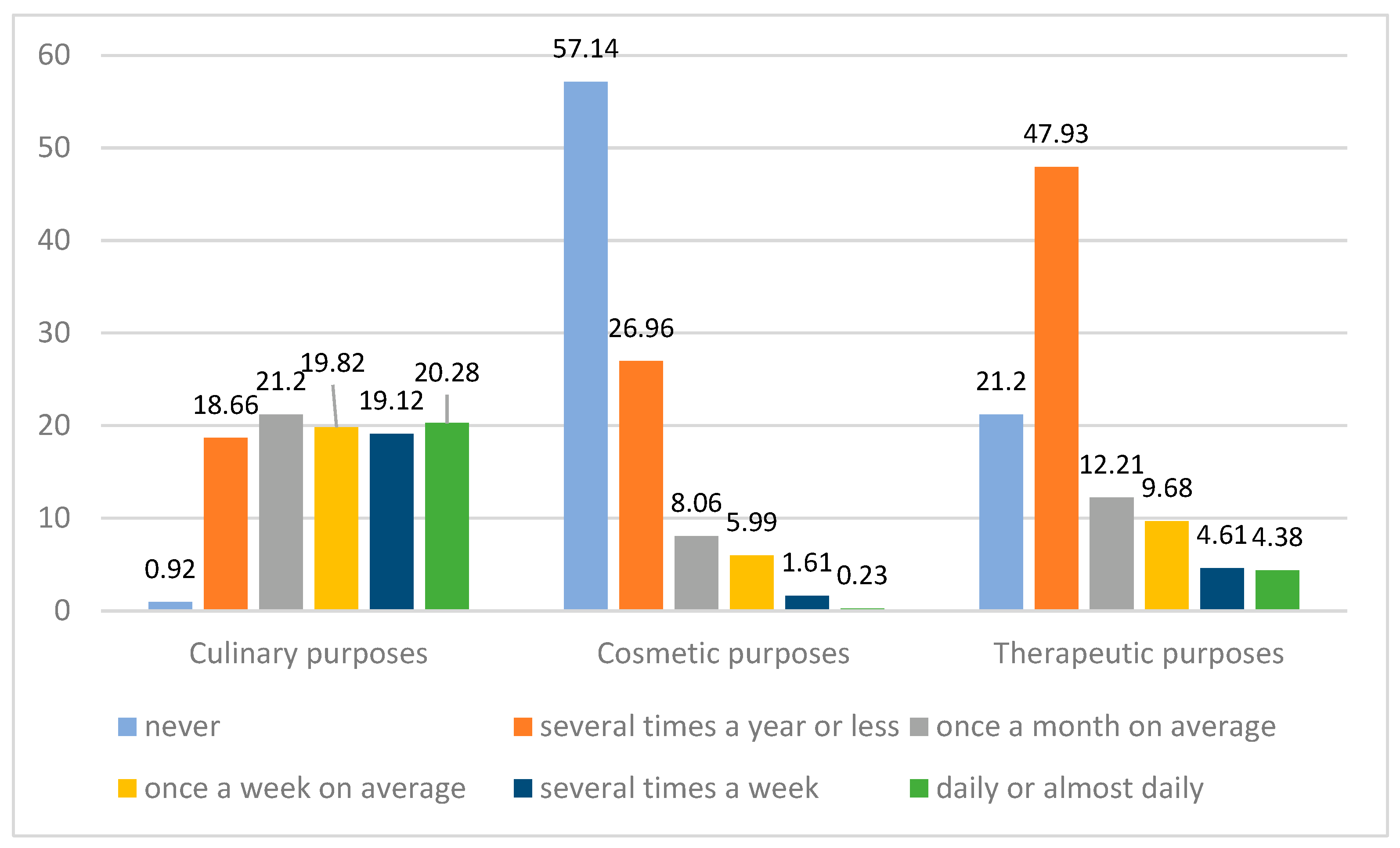
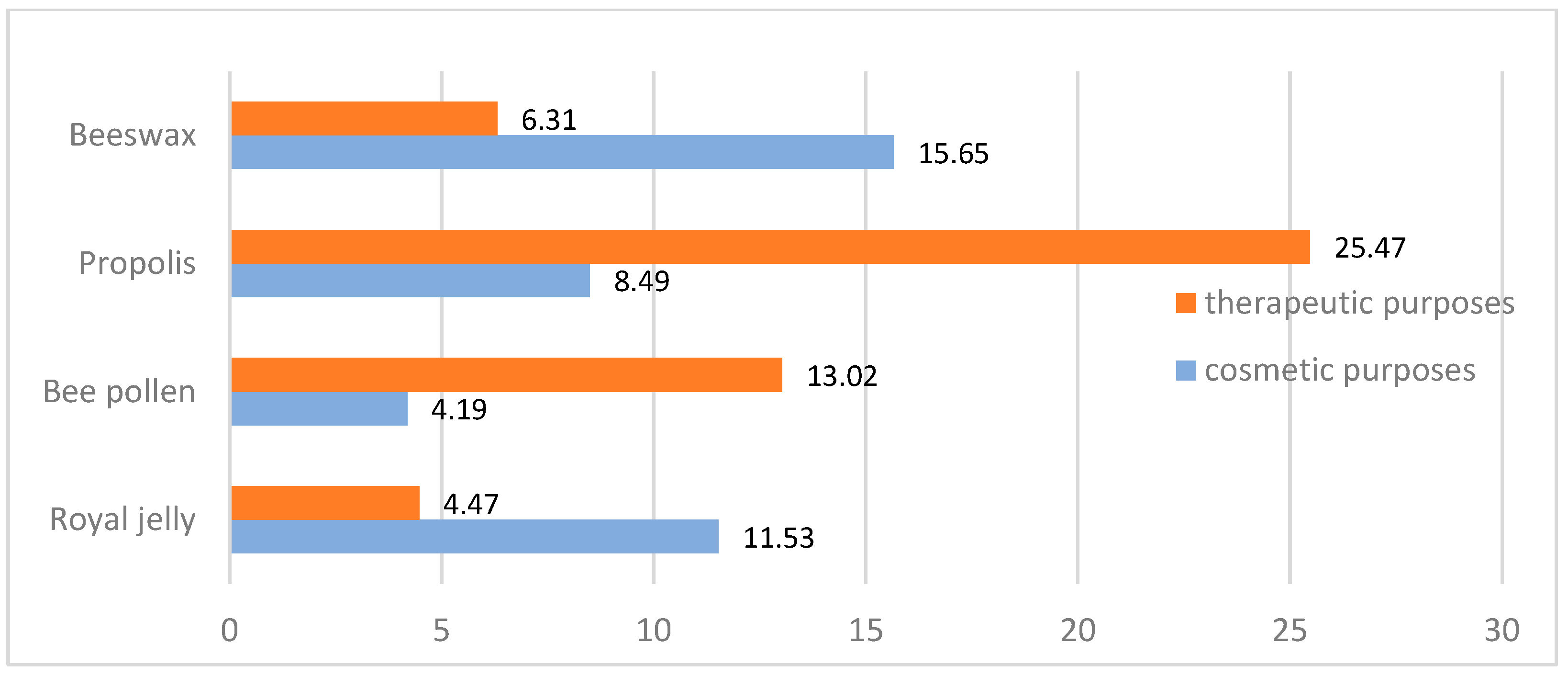
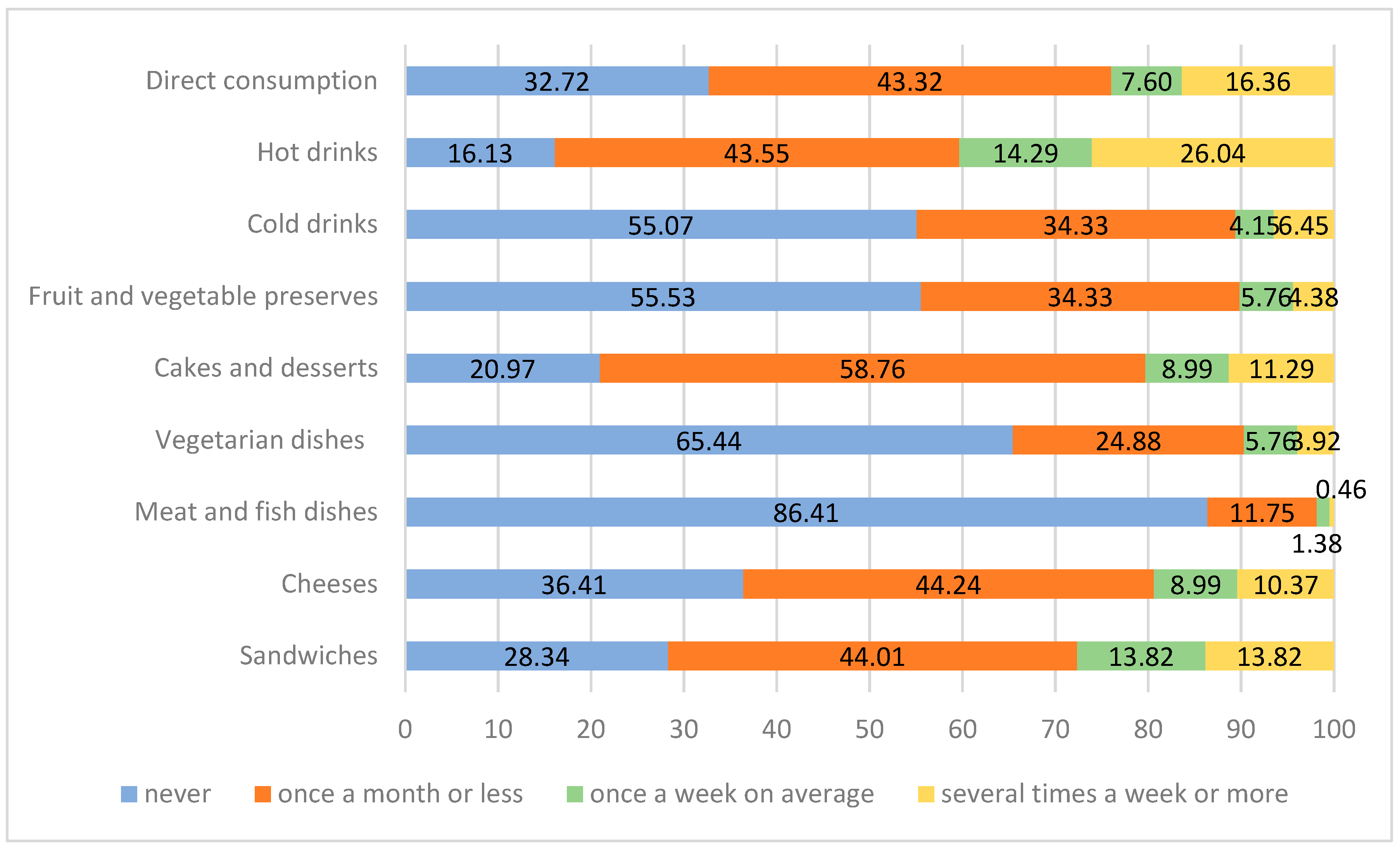
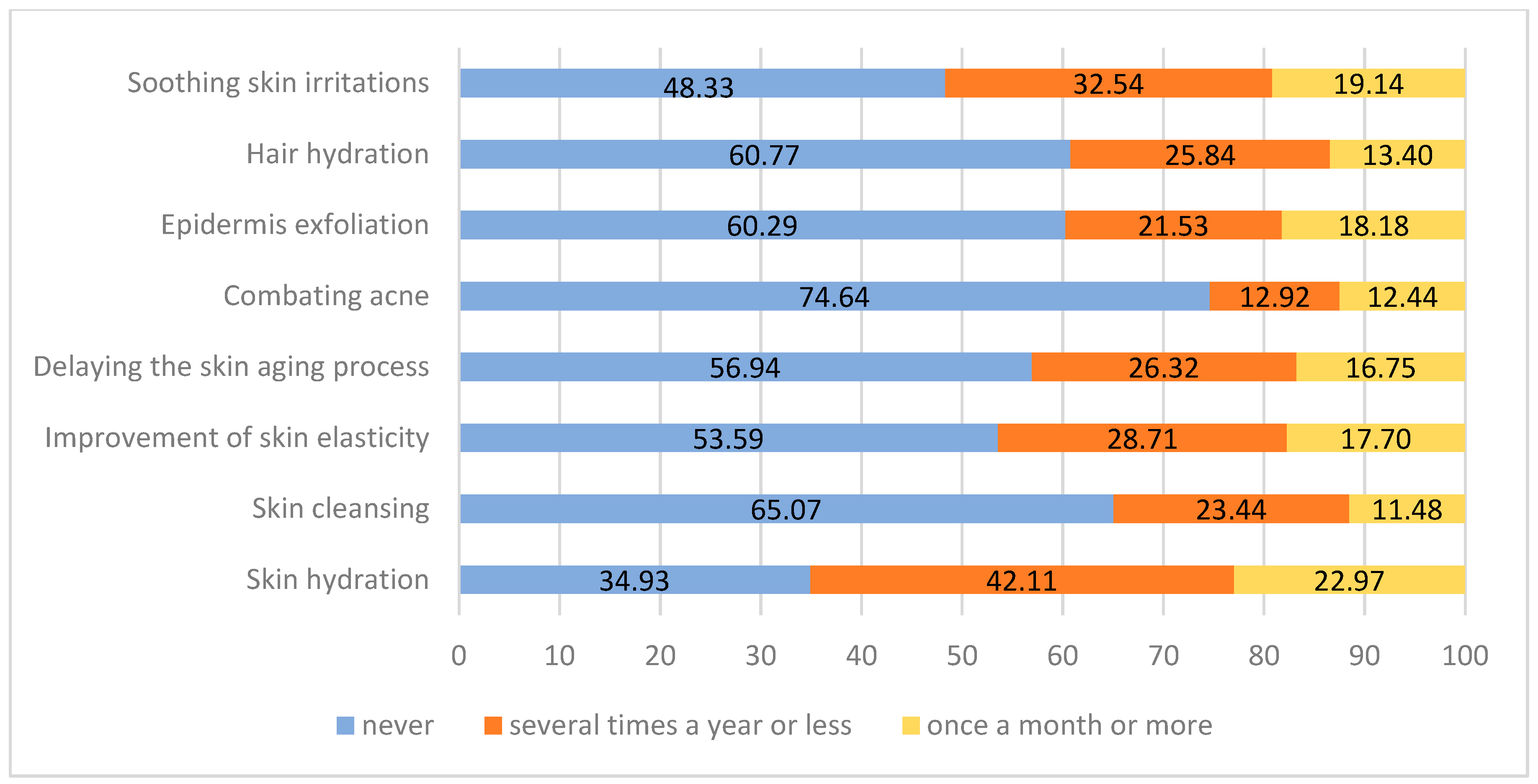
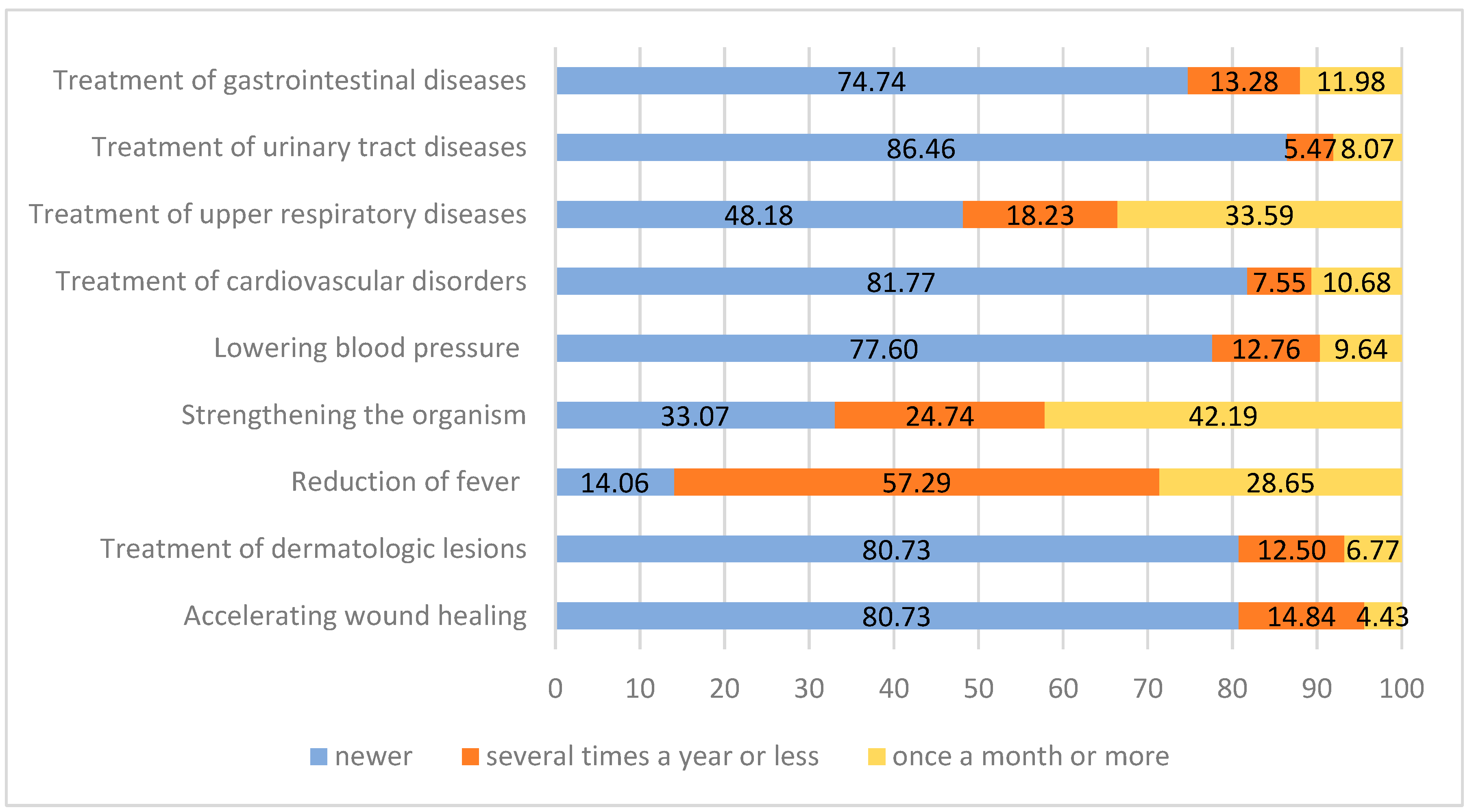
| Gender | |
| Female | 57.14 |
| Male | 42.86 |
| Age | |
| 18–30 years old | 43.09 |
| 31–45 years old | 26.73 |
| 46–60 years old | 17.97 |
| Over 60 years old | 12.21 |
| Education | |
| Primary, vocational | 3.69 |
| Secondary | 35.71 |
| Higher | 60.60 |
| Per Capita Income PLN/EUR * | |
| Under 2500 PLN/534.2 EUR | 32.95 |
| 2501–5000 PLN/534.4–1068.4 EUR | 40.78 |
| Above 5000 PLN/1068.4 EUR | 26.27 |
| Place of residence | |
| Village | 23.04 |
| City up to 50 thousand residents | 17.51 |
| City of 50–250 thousand inhabitants | 16.36 |
| City of more than 250 thousand inhabitants | 43.09 |
| Number of household members | |
| 1 | 12.21 |
| 2 | 31.80 |
| 3 | 25.12 |
| 4 | 19.59 |
| 5 and more | 13.29 |
| Nutritional knowledge | |
| Very bad and bad | 3.23 |
| Average | 36.41 |
| Good | 45.61 |
| Very good | 14.75 |
| Health self-assessment | |
| Very bad and bad | 5.76 |
| Average | 20.28 |
| Good | 54.15 |
| Very good | 19.81 |
| Specification Share in the Study Population | HE 27.92 | HRU 44.55 | HU 16.63 | p-Value |
|---|---|---|---|---|
| Frequency of use of honey for culinary purposes | 4.01 *b | 1.78 c | 4.48 a | <0.0001 |
| Frequency of use of honey for cosmetic purposes | 0.22 c | 0.64 b | 1.60 a | <0.0001 |
| Frequency of use of honey for medicinal purposes | 0.77 c | 1.18 b | 3.15 a | <0.0001 |
| Specification | HE 27.87 | HRU 44.55 | HU 16.63 | p-Value | |
|---|---|---|---|---|---|
| Share in the Study Population | |||||
| Gender | Female | 22.98 | 54.04 | 22.98 | <0.0001 |
| Male | 44.47 | 42.63 | 12.91 | ||
| Age | 18–30 | 27.81 | 56.15 | 16.04 | 0.0089 |
| 31–45 | 37.93 | 43.97 | 18.10 | ||
| 46–60 | 32.05 | 53.85 | 14.10 | ||
| Over 60 years | 28.30 | 35.85 | 35.85 | ||
| Income (per capita) | Under PLN 2500 | 23.78 | 62.23 | 13.99 | 0.0150 |
| PLN 2501–5000 | 33.33 | 43.51 | 23.16 | ||
| Above PLN 5000 | 37.72 | 44.74 | 17.54 | ||
| Specification Share in the Study Population | HE 27.87 | HRU 44.55 | HU 16.63 | p-Value | |
|---|---|---|---|---|---|
| Use of royal jelly for cosmetic purposes | No | 34.57 | 47.88 | 17.55 | 0.0008 |
| Yes | 8.16 | 69.39 | 22.45 | ||
| Use of bee pollen for cosmetic purposes | No | 32.52 | 48.55 | 18.93 | 0.0301 |
| Yes | 5.56 | 77.77 | 16.67 | ||
| Use of propolis for cosmetic purposes | No | 32.47 | 47.17 | 20.36 | 0.0001 |
| Yes | 13.89 | 83.33 | 2.78 | ||
| Use of bee wax for cosmetic purposes | No | 34.35 | 47.64 | 18.01 | 0.0070 |
| Yes | 14.93 | 61.19 | 23.88 | ||
| Use of royal jelly for medicinal purposes | No | 32.51 | 51.23 | 16.26 | <0.0001 |
| Yes | 10.53 | 31.58 | 57.89 | ||
| Use of bee pollen for medicinal purposes | No | 33.96 | 48.93 | 17.11 | 0.0042 |
| Yes | 14.29 | 55.35 | 30.36 | ||
| Use of propolis for medicinal purposes | No | 30.70 | 56.33 | 12.97 | <0.0001 |
| Yes | 31.48 | 32.41 | 36.11 | ||
| Use of bee wax for medicinal purposes | No | 31.42 | 51.37 | 17.21 | 0.0013 |
| Yes | 29.63 | 25.93 | 44.44 | ||
| Specification Share in the Study Population | HE 27.87 | HRU 44.55 | HU 16.63 | p-Value | |
|---|---|---|---|---|---|
| Personal preferences | No | 23.4 | 57.45 | 19.15 | 0.1530 |
| Yes | 33.53 | 47.94 | 18.53 | ||
| Suggestions from family and friends | No | 36.50 | 46.00 | 17.50 | 0.0996 |
| Yes | 26.92 | 53.42 | 19.66 | ||
| Habits | No | 27.19 | 57.46 | 15.35 | 0.0045 |
| Yes | 35.92 | 41.75 | 22.33 | ||
| Deterioration of health | No | 31.99 | 48.45 | 19.57 | 0.5184 |
| Yes | 29.46 | 54.46 | 16.07 | ||
| Suggestions from doctors and nutritionists | No | 33.06 | 49.73 | 17.21 | 0.0470 |
| Yes | 22.06 | 51.47 | 26.47 | ||
| Fashion | No | 31.44 | 50.12 | 18.44 | 0.7579 |
| Yes | 27.27 | 45.45 | 27.27 | ||
| Specification Share in the Study Population | HE 27.87 | HRU 44.55 | HU 16.63 | p-Value | |
|---|---|---|---|---|---|
| Family and friends | No | 32.54 | 42.6 | 24.85 | 0.0121 |
| Yes | 30.57 | 54.72 | 14.72 | ||
| Internet nutrition portals | No | 33.19 | 52.40 | 14.41 | 0.0453 |
| Yes | 29.27 | 47.32 | 23.41 | ||
| Books and magazines | No | 31.16 | 49.66 | 19.18 | 0.9250 |
| Yes | 31.69 | 50.7 | 17.61 | ||
| Vendors | No | 34.2 | 50.49 | 15.31 | 0.0104 |
| Yes | 24.41 | 48.82 | 26.77 | ||
| Social media | No | 32.04 | 51.50 | 16.47 | 0.0491 |
| Yes | 29.00 | 45.00 | 26.00 | ||
| Television and radio | No | 31.78 | 50.65 | 17.57 | 0.2452 |
| Yes | 27.66 | 44.68 | 27.66 | ||
| Doctors and nutritionists | No | 32.74 | 50.64 | 16.62 | 0.0030 |
| Yes | 18.6 | 44.19 | 37.21 | ||
| Specification Share in the Study Population | HE 27.87 | HRU 44.55 | HU 16.63 | p-Value | |
|---|---|---|---|---|---|
| Self-assessment of nutritional knowledge | Very bad and bad | 57.14 | 35.72 | 7.14 | 0.0067 |
| Average | 32.91 | 55.70 | 11.39 | ||
| Good | 29.29 | 46.47 | 24.24 | ||
| Very good | 28.13 | 50.00 | 21.87 | ||
| Self-assessment of health status | Very bad and bad | 16.00 | 56.00 | 28.00 | 0.0072 |
| Average | 27.68 | 62.09 | 10.23 | ||
| Good | 29.36 | 51.92 | 18.72 | ||
| Very good | 41.86 | 33.72 | 24.42 | ||
| Specification | Variable Level | Estimate | Point Estimate | 95% Wald Confidence Limits | Pr > ChiSq | |
|---|---|---|---|---|---|---|
| Intercept | 0.301 | 0.5635 | ||||
| Use of honey to treat digestive ailments | Yes No (ref.) | 0.3416 0 | 1.407 | 1.03 | 1.93 | 0.0345 |
| Use of propolis for medicinal purposes | Yes | 0.5202 | 1.682 | 1.29 | 3.01 | 0.0379 |
| No (ref.) | 0 | . | ||||
| Deterioration of health as a reason for using bee products | Yes | −0.7856 | 0.456 | 0.27 | 0.76 | 0.0026 |
| No (ref.) | 0 | . | ||||
| Suggestions from doctors and nutritionists as a reason for using bee products | Yes | −0.8698 | 0.419 | 0.23 | 0.77 | 0.0050 |
| No (ref.) | 0 | |||||
| Specification | Variable Level | Estimate | Point Estimate | 95% Wald Confidence Limits | Pr > ChiSq | |
|---|---|---|---|---|---|---|
| Intercept | −0.1831 | 0.698 | ||||
| Use of honey to treat digestive ailments | Yes | 0.55590 | 1.744 | 1.25 | 2.44 | 0.0011 |
| No (ref.) | ||||||
| Use of propolis for medicinal purposes | Yes | 0.869 | 2.385 | 1.42 | 4.01 | 0.001 |
| No (ref.) | 0 | |||||
| Deterioration of health as a reason for using bee products | Yes | −0.7179 | 0.488 | 0.30 | 0.79 | 0.0035 |
| No (ref.) | 0 | . | ||||
Disclaimer/Publisher’s Note: The statements, opinions and data contained in all publications are solely those of the individual author(s) and contributor(s) and not of MDPI and/or the editor(s). MDPI and/or the editor(s) disclaim responsibility for any injury to people or property resulting from any ideas, methods, instructions or products referred to in the content. |
© 2023 by the authors. Licensee MDPI, Basel, Switzerland. This article is an open access article distributed under the terms and conditions of the Creative Commons Attribution (CC BY) license (https://creativecommons.org/licenses/by/4.0/).
Share and Cite
Kowalczuk, I.; Gębski, J.; Stangierska, D.; Szymańska, A. Determinants of Honey and Other Bee Products Use for Culinary, Cosmetic, and Medical Purposes. Nutrients 2023, 15, 737. https://doi.org/10.3390/nu15030737
Kowalczuk I, Gębski J, Stangierska D, Szymańska A. Determinants of Honey and Other Bee Products Use for Culinary, Cosmetic, and Medical Purposes. Nutrients. 2023; 15(3):737. https://doi.org/10.3390/nu15030737
Chicago/Turabian StyleKowalczuk, Iwona, Jerzy Gębski, Dagmara Stangierska, and Agata Szymańska. 2023. "Determinants of Honey and Other Bee Products Use for Culinary, Cosmetic, and Medical Purposes" Nutrients 15, no. 3: 737. https://doi.org/10.3390/nu15030737
APA StyleKowalczuk, I., Gębski, J., Stangierska, D., & Szymańska, A. (2023). Determinants of Honey and Other Bee Products Use for Culinary, Cosmetic, and Medical Purposes. Nutrients, 15(3), 737. https://doi.org/10.3390/nu15030737










